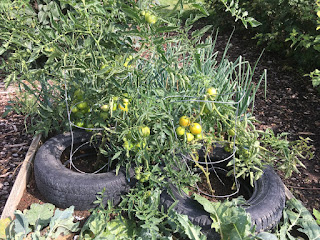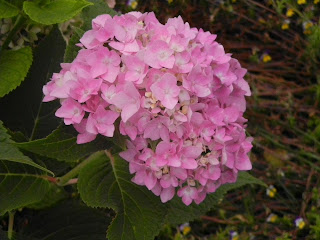The Great Tomato Challenge Continues
 |
| Beef Steak Variety taken a week ago |
Here's a rundown of the challenges I've faced and the measures I've taken to reach this point.
As I said in my previous post, the disease I suspect I need to be protecting against is blight, which is a fungal disease. Maintaining good air circulation through the plant and not watering by sprinklers both help to keep the plants dry and minimize the chance of fungal diseases growing. I've had a big problem when it comes to that. The end gun on the pivot behind our house hits our garden. It is our field, and we could tell the farmer who is running it to turn the gun off before it reaches us, but we like to take advantage of it to help keep the garden watered. However, it does mean the plant leaves do get wet.
Fortunately, the summer days have been hot, which helps the plants dry out after being watered. Additionally, I took two organic measures to help fight any fungal diseases before they could get started.
 |
| Beef Steak after initial pruning |
think of pruning, you think of trees and shrubs. However, pruning is just cutting off part of a plant, and that is often good for herbaceous plants as well as woody ones. Removing the lowest branches of tomatoes keeps the leaves from touching the ground where fungal spores may be lurking. It also helps to improve air circulation through the plant, which will help to dry the plant out after it is watered.
The second measure was to spray the plants with diluted milk. I found this idea on a site which gave organic, homemade pest control recipes. Apparently milk has anti-fungal properties. I diluted it half and half with water and sprayed the plants until the milk was dripping off the leaves. If mixing milk into the soil attracted my cats, you should see how they react to milk dripping off the plants. I repeated this about every week for the first month.
 Up until that point things seemed to be going really well. Then life got hectic. I had a couple of weeks in a row where I didn't have time for gardening. When I did get back to it, some of the plants were beginning to show signs of disease. It was time for drastic measures. I cut off all the diseased branches. Diseased plants should not go on the compost pile, so these went straight into a garbage bag and into the bin. Then I sprayed the plants with a commercial fungicide.
Up until that point things seemed to be going really well. Then life got hectic. I had a couple of weeks in a row where I didn't have time for gardening. When I did get back to it, some of the plants were beginning to show signs of disease. It was time for drastic measures. I cut off all the diseased branches. Diseased plants should not go on the compost pile, so these went straight into a garbage bag and into the bin. Then I sprayed the plants with a commercial fungicide.Since then, at least once a week I've examined the plants and cut off any diseased branches. When I do so I carry to bucket of water with a little bleach in it. I dip my pruners into the water between cuts to help keep from spreading disease. Then I've sprayed the plants with diluted milk. I've been tempted a time or two to use the commercial fungicide again. It is safe to eat plants which have been sprayed with it, but there is a wait time between application and harvest. This wait time varies from one vegetable to another. Some of my tomatoes are planted in raised beds with other vegetables, and I knew the spray wouldn't hit just the tomatoes. That means I'd have to keep track of the wait time for each veggie in the beds. Rather than do that, I've opted to use the milk. So far it seems to be helping, but if that changes, I may go to the fungicide in the future.
Here's how each variety has fared. I've categorized them by whether or not at this point I would grow them again.
Will Definitely Grow Again
 |
| Big Boy taken a week ago |
Super Fantastic: Despite growing in the harsher conditions area, this plant has thrived and produced well.
Might Grow Again
Beefsteak: This variety has done well for me in the past, but has struggled a little this year. It was the plant I first saw disease in, and at times I've felt like I was cutting out half the plant when I've pruned out the bad branches. Still, it has managed to stay fairly healthy looking, if not a bit spindly. The tomatoes it
has produced have been smaller than I'd
 |
| Super Fantastic taken a week ago |
Celebrity: This is another one that was planted in the harsher area. While it hasn't thrived the way Super Fantastic has, it has done well enough that I'd like to see how it would do in better soil.
4th of July: This plant did not live up to it's name; it didn't produce tomatoes any earlier than the other varieties I planted. However, like Celebrity, it has managed to do decently well even in the harsher conditions, so I might give it another go.
Won't Grow Again
 |
| 42 Days taken a week ago |
Hamson: This plant stayed compact and dense, making it hard to maintain good air circulation or to spray the branches inside the plant. Plus the tomatoes it has produced have been quite small.
42 days: This plant did the worst of all. It hardly grew after I planted it, and while it was covered with green tomatoes early on, they were very small and slow to ripen. When the disease hit, I would have had to cut off nearly every branch on this plant to get rid of it. I ended up digging up and throwing away the entire plant about a week ago.
So there's how things stand at this point. I hope to be able to keep the plants alive and producing into September. We'll see how things go.



Comments
Post a Comment